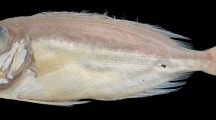Abstract
The present study provides further data on the occurrence of Pseudoterranova decipiens in fish from two different sampling sites in the Antarctic. A total of 690 fish belonging to 33 species from the eastern Weddell Sea and 322 fish belonging to 12 species from the South Shetland Islands were examined. Altogether, 23 fish species were found to be infested and 11 new host records could be established. P. decipiens occurred at a water depth of between 80 and 820 m. Chaenocephalus aceratus and Notothenia coriiceps from the South Shetland Islands were the species with the highest prevalence (95%) and intensity (2–194 and 1–121, respectively) of infestation. Both are transport hosts, which mainly feed on benthic nototheniid fish species and accumulate the nematodes. Bathypelagic, pelagic, or mainly euphausid feeding fish species were only lightly infested, if at all. This demonstrates the benthic life cycle of P. decipiens in the Antarctic. The preferred site of infestation was the body cavity and the liver; no specimen could be isolated from the fish musculature. This might be explained by the low water temperatures. The infestation of fish from the Weddell Sea was distinctly lower than that of fish around the South Shetland Islands. Besides possible differences in final host populations at the two localities studied, the loss of eggs and larvae under the eastern Weddell Sea shelf ice and over the continental slope and differences in the availability of the first intermediate and macroinvertebrate hosts led to a lower level of infestation. Another role, although nondecisive, may be played by the reduced time of development and infectivity of eggs and larvae, respectively, in the extremely cold waters of the Weddell Sea. P. decipiens is not a rare but, rather a well-established parasite of the Antarctic fauna, which demonstrates the ability of this cosmopolitan species to complete its life cycle even under conditions of subzero temperatures.
Similar content being viewed by others
Author information
Authors and Affiliations
Additional information
Received: 8 March 1999 / Accepted: 29 March 1999
Rights and permissions
About this article
Cite this article
Palm, H. Ecology of Pseudoterranova decipiens (Krabbe, 1878) (Nematoda: Anisakidae) from Antarctic waters. Parasitol Res 85, 638–646 (1999). https://doi.org/10.1007/s004360050608
Issue Date:
DOI: https://doi.org/10.1007/s004360050608




